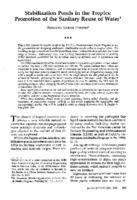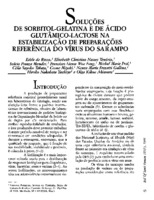Stabilization ponds in the tropics: Promotion of the sanitary reuse of water
Date
1993Author
Metadata
Show full item recordAbstract
This article reports the results of efforts by PAHO's Environmental Health Program to lay the groundwork for designing wasterwater stabilization ponds suited to tropical areas. The resulting design concepts are flexible (permitting pond construction to be adapted to a broad range of terrains, community sizes, and working temperatures) and directed at meeting WHO standards established for the microbial quality of effluents used in agriculture and aquaculture. The WHO standards (1) call for treated wastewater being used in agriculture or aquaculture to contain less than 1 000 fecal coliforms per 100 ml. The plans outlined here, which are calculated to meet those standards, seek to minimize the pond area and volume needed by using two high-load primary anaerobic ponds discharging into an elongated secondary pond with a length-to-width ratio of at least 15:1. In rough terrain the elongated pond can be allowed to meander, following the land's natural contours. However, where the terrain is level it is recommended that a system of partitions be used to maintain the 15:1 ratio for operating purposes while changing the actual ratio of the secondary pond's outer dimensions to something like 5:3 This article will also be published in Spanish in the Bol. Oficina Sanit. Panam. Vol. 115. No. 6, 1993
Subject
Collections
Related items
Showing items related by title, author, creator and subject.
-
Costa, Elisa Miranda; Rocha, Núbia Cristina da Silva; Rocha, Thiago Augusto Hernandes; Lima, Hassan Lavalier de Oliveira; Vissoci, João Ricardo Nickenig; Queiroz, Rejane Christine de Sousa; Fonseca Thomaz, Erika Barbara Abreu (2022)[ABSTRACT]. Objective. To assess the effect of coverage of the Bolsa Família Program (BFP) on oral cancer mortality rates in Brazil between 2005 and 2017, adjusting for health care coverage and socioeconomic characteristics ...
-
Rizzo, Eda de; Nunez Tenorio, Elisabeth Christina; Mendes, Inacio Franca; Liauw Woe Fang, Francisco; Pral, Michel Marie; Sayoko Takata, Celia; Miyaki, Cosue; Frazatti Gallina, Neuza Maria; Nakahata Tuchiya, Hiroko; Kikue Akimura, Olga (s.d.)The study described in this article was carried out for the purpose of evaluating the protective effects of two stabilizing solutions- sorbitol-gelatin and glutamic acid-lactose- on freeze-dried measles virus (Schwartz ...
-
Niermeyer, Susan; Domek, Gretchen (CLAPUruguayMontevideo, 2016)Background: Reduction in neonatal mortality is central to achieving global child survival targets in the coming decades. Efforts to prevent the primary causes of neonatal death (prematurity, asphyxia, severe infections, ...




